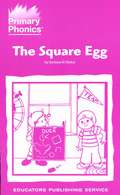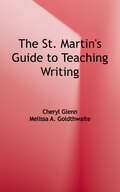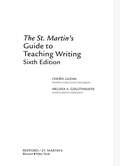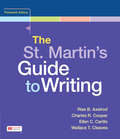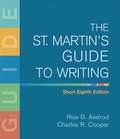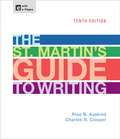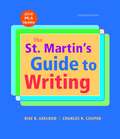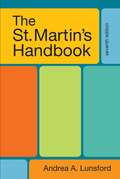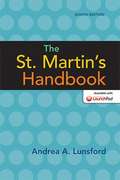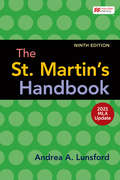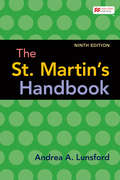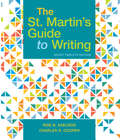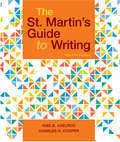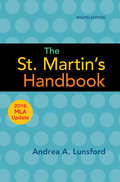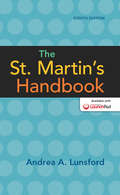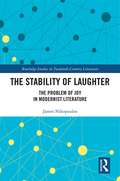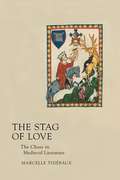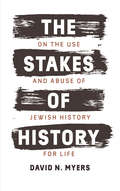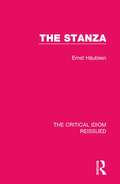- Table View
- List View
The St. Martin's Guide to Teaching Writing
by Cheryl Glenn Melissa A. GoldthwaiteThis Guide includes coverage of current central concerns of rhetoric and composition along with a brief anthology of scholarly essays and coverage of constructing successful assignments using visual, oral, and electronic texts; teaching multilingual writers; and using technology in the writing classroom.
The St. Martin's Guide to Teaching Writing
by Cheryl Glenn Melissa A. GoldthwaiteThis guide to teaching writing and to major theoretical issues includes a brief anthology of scholarly essays and new coverage of constructing successful assignments using visual, oral, and electronic texts; teaching multilingual writers; and using technology in the writing classroom.
The St. Martin's Guide to Writing
by Rise B. Axelrod Charles R. Cooper Wallace Cleaves Ellen CarilloThe comprehensive resource for helping students succeed in the full variety of assignments they’ll face in first-year writing courses.
The St. Martin's Guide to Writing (8th Edition)
by Rise B. Axelrod Charles R. CooperThe book can serve as a comprehensive introduction to nine genres of writing. It prepares the students for the kinds of writing specific to academic discourse It has examples for specific kind of writing which helps you to write your own essays.
The St. Martin's Guide to Writing (Short Tenth Edition)
by Rise B. Axelrod Charles R. CooperThe best-selling college rhetoric for over 25 years, The St. Martin's Guide has achieved an unmatched record of success by providing practical innovations for the ever-changing composition course. The acclaimed step-by-step Guides to Writing offer sure-fire invention strategies to get students started, sentence strategies to get and keep students writing, and thoughtful revision strategies to help students make their writing their own. With more hands-on activities for critical reading and working with sources, greater emphasis on the rhetorical situation, a revamped design that helps students see what they need to do at a glance, and a greater variety of formats (cloth, paper, loose-leaf, and e-books), the Guide is better than ever. The print text is now integrated with e-Pages for The St. Martin's Guide, designed to take advantage of what the Web can do.
The St. Martin's Guide to Writing (Tenth Edition)
by Rise B. Axelrod Charles R. CooperThe best-selling college rhetoric for over 25 years, The St. Martin's Guide has achieved an unmatched record of success by providing practical innovations for the ever-changing composition course. The acclaimed step-by-step Guides to Writing offer sure-fire invention strategies to get students started, sentence strategies to get and keep students writing, and thoughtful revision strategies to help students make their writing their own. With more hands-on activities for critical reading and working with sources, greater emphasis on the rhetorical situation, a revamped design that helps students see what they need to do at a glance, and a greater variety of formats (cloth, paper, loose-leaf, and e-books), the Guide is better than ever. The print text is now integrated with e-Pages for The St. Martin's Guide, designed to take advantage of what the Web can do.
The St. Martin's Guide to Writing with 2016 MLA Update (11th Edition)
by Rise B. Axelrod Charles R. CooperTHIS TITLE HAS BEEN UPDATED TO REFLECT THE 2016 MLA UPDATES! Our editorial team has updated this text based on content from The MLA Handbook, 8th Edition. Browse our catalog or contact your representative for a full listing of updated titles and packages, or to request a custom ISBN. Whether you have years of experience as a teacher or are new to the classroom, you and your students can count on The St. Martin's Guide to Writing to provide the support you need in first-year composition, with a rhetoric, an array of engaging readings, a research manual, and a handbook, all in a single book -- and available online. Thousands of instructors and their students rely on the Guide's proven approach because it works: the Guide's acclaimed step-by-step writing guides to 9 different genres offer sure-fire invention strategies to get students started, sentence strategies to get students writing, and thoughtful revision strategies to help students make their writing their own, no matter what their major. With its hands-on activities for reading like a writer and working with sources, there is no better text to help students bridge reading analytically to successful writing in first-year composition and beyond. In keeping with the Guide's tradition of innovation and based on instructor feedback about what assignments they give their students, the new edition integrates new types of writing that reflect the range of genres being assigned in first-year composition, including a reimagined Chapter 5 that provides a bridge from personal and expository to argumentative writing by following a scaffolded approach. The eleventh edition is available with LaunchPad for The St. Martin's Guide to Writing, an online course space of pre-built units featuring the full e-book, tutorials, and adaptive LearningCurve activities to help students hone their understanding of reading and writing. To order or purchase the print text with LaunchPad, use ISBN 9781457698484 for the Cloth-bound version, ISBN 9781319016036 for the Paper-bound version, or ISBN 9781319016067 for the Short Edition.
The St. Martin's Handbook (7th Edition)
by Andrea A. LunsfordAndrea A. Lunsford's latest findings show that today's students write more than ever before -- and make rhetorically appropriate choices in texts they create outside the classroom. "We're in the midst of a literacy revolution the likes of which we haven't seen since Greek civilization," she notes. The St. Martin's Handbook, Seventh Edition is the first handbook to help students build on the smart decisions they make as recreational writers in order to succeed in their academic and professional work. And,The St. Martin's Handbook is the all-in-one teaching tool and reference that shows students how to write effectively for any purpose.
The St. Martin's Handbook 8th Edition
by Andrea A. LunsfordAndrea Lunsford’s comprehensive advice in The St. Martin’s Handbook, Eighth Edition, supports students as they move from informal, social writing to both effective academic writing and to writing that can change the world.
The St. Martin's Handbook with 2021 MLA Update
by Andrea LunsfordThis ebook has been updated to provide you with the latest guidance on documenting sources in MLA style and follows the guidelines set forth in the MLA Handbook, 9th edition (April 2021). Andrea Lunsford’s comprehensive advice in The St. Martin’s Handbook, Eighth Edition, supports students as they move from informal, social writing to both effective academic writing and to writing that can change the world. Based on Andrea’s groundbreaking research on the literacy revolution, this teachable handbook shows students how to reflect on the writing skills they already have and put them to use both in traditional academic work and in multimodal projects like blog posts, websites, and presentations. Integrated advice on U.S. academic genres and language follows best practices for helping students from both international and native-speaker backgrounds improve their understanding of academic English. Throughout The St. Martin’s Handbook, Andrea Lunsford encourages all of today’s students to learn everything they need to communicate effectively with the diverse people sharing their classrooms, workspaces, and civic lives.
The St. Martin's Handbook: (custom Edition Central Texas College)
by Andrea LunsfordThe most rhetorically grounded comprehensive handbook for composition, The St. Martin’s Handbook continues to do what it has always done: Present Andrea Lunsford’s substantial and timely research with student writers for student writers. The ninth edition reflects a nationwide survey of students and teachers related to how young people interact with others from different language and cultural backgrounds and with people with whom they disagree. New material on college expectations helps students think critically about barriers to and benefits of open and respectful dialogue and offers strategies for communicating outside of one’s comfort zone. Attention to gender and pronouns and to language varieties and identities supports students as they learn to write to include rather than to exclude. And throughout the ninth edition, which assumes students are writing traditional and multimodal projects in a mobile world, Andrea Lunsford asks students to see themselves as communicators in a global world. With new student writing, stronger coverage of argument, new material on defensive reading and fact-checking, more visual help with field research, the most up-to-date citation models, and a range of practice activities, The St. Martin’s Handbook helps a wide variety of college writers succeed.
The St. Martins Guide to Public Speaking
by Douglas M. Fraleigh Joseph S. TumanThis succinct guide offers practical coverage of the material typically covered in a full-sized text - from invention, research, and organization to practice and delivery - in a concise, perfect for any setting across the curriculum, on the job, or in the community.
The St. Martin’s Guide to Writing (Short Eleventh Edition)
by Rise B. Axelrod Charles R. CooperWhether you have years of experience as a teacher or are new to the classroom, you and your students can count on The St. Martin’s Guide to Writing to provide the support you need in first-year composition, with a rhetoric, an array of engaging readings, a research manual, and a handbook, all in a single book — and available online. Thousands of instructors and their students rely on the Guide’s proven approach because it works: the Guide’s acclaimed step-by-step writing guides to 9 different genres offer sure-fire invention strategies to get students started, sentence strategies to get students writing, and thoughtful revision strategies to help students make their writing their own, no matter what their major. With its hands-on activities for reading like a writer and working with sources, there is no better text to help students bridge reading analytically to successful writing in first-year composition and beyond. <P> In keeping with the Guide’s tradition of innovation and based on instructor feedback about what assignments they give their students, the new edition integrates new types of writing that reflect the range of genres being assigned in first-year composition, including a reimagined Chapter 5 that provides a bridge from personal and expository to argumentative writing by following a scaffolded approach.
The St. Martin’s Guide to Writing (Short Twelfth Edition): Short
by Charles R. Cooper Rise AxelrodWhether you have years of teaching experience or are new to the classroom, you and your students can count on The St. Martin’s Guide to Writing to provide the thoroughly class-tested support you need for first-year composition, with a rhetoric, an array of engaging readings, a research manual, and a handbook, all in a single book — and available online in LaunchPad. Thousands of instructors and their students rely on the Guide’s proven approach because it works: Acclaimed step-by-step reading and writing guides to 9 different genres offer sure-fire invention that get students started and revision strategies that help them develop their writing. The new edition continues in its mission to serve a diverse audience of schools and students with an improved, accessible design, new support for reflection that encourages transfer, and a new Student’s Companion for students taking co-requisite or ALP courses.
The St. Martin’s Guide to Writing (Twelfth Edition)
by Charles R. Cooper Rise AxelrodWhether you have years of teaching experience or are new to the classroom, you and your students can count on The St. Martin’s Guide to Writing to provide the thoroughly class-tested support you need for first-year composition, with a rhetoric, an array of engaging readings, a research manual, and a handbook, all in a single book — and available online in LaunchPad. Thousands of instructors and their students rely on the Guide’s proven approach because it works: Acclaimed step-by-step reading and writing guides to 9 different genres offer sure-fire invention that get students started and revision strategies that help them develop their writing. The new edition continues in its strategies to serve a diverse audience of schools and students with an improved, accessible design, new support for reflection that encourages the transfer, and a new Student’s Companion for students taking co-requisite or ALP courses.
The St. Martin’s Handbook
by Andrea A. LunsfordPACKAGE THIS TITLE WITH OUR 2016 MLA SUPPLEMENT, Documenting Sources in MLA Style (package ISBN-13: 9781319087371). Get the most recent updates on MLA citation in a convenient, 40-page resource based on The MLA Handbook, 8th Edition, with plenty of models. Browse our catalog or contact your representative for a full listing of updated titles and packages, or to request a custom ISBN. Andrea Lunsford's comprehensive advice in The St. Martin's Handbook, Eighth Edition, supports students as they move from informal, social writing to both effective academic writing and to writing that can change the world. Based on Andrea's groundbreaking research on the literacy revolution, this teachable handbook shows students how to reflect on the writing skills they already have and put them to use both in traditional academic work and in multimodal projects like blog posts, websites, and presentations. Integrated advice on U. S. academic genres and language follows best practices for helping students from both international and native-speaker backgrounds improve their understanding of academic English. Throughout The St. Martin's Handbook, Andrea Lunsford encourages all of today's students to learn everything they need to communicate effectively with the diverse people sharing their classrooms, workspaces, and civic lives. See what's in the LaunchPad
The St. Martin’s Handbook
by Andrea A. LunsfordAndrea Lunsford's comprehensive advice in The St. Martin's Handbook, Eighth Edition, supports students as they move from informal, social writing to both effective academic writing and to writing that can change the world. Based on Andrea's groundbreaking research on the literacy revolution, this teachable handbook shows students how to reflect on the writing skills they already have and put them to use both in traditional academic work and in multimodal projects like blog posts, websites, and presentations. Integrated advice on U. S. academic genres and language follows best practices for helping students from both international and native-speaker backgrounds improve their understanding of academic English. Throughout The St. Martin's Handbook, Andrea Lunsford encourages all of today's students to learn everything they need to communicate effectively with the diverse people sharing their classrooms, workspaces, and civic lives.
The Stability of Laughter: The Problem of Joy in Modernist Literature (Routledge Studies in Twentieth-Century Literature)
by James NikopoulosA "sad and corrupt" age, a period of "crisis" and "upheaval"—what T.S. Eliot famously summed up as "the panorama of futility and anarchy which is contemporary history." Modernism has always been characterized by its self-conscious sense of suffering. Why, then, was it so obsessed with laughter? From Baudelaire, Nietzsche, Bergson and Freud to Pirandello, Beckett, Hughes, Barnes, and Joyce, no moment in cultural history has written about laughter this much. James Nikopoulos investigates modernity’s paradoxical relationship with mirth. Why was the gesture we conventionally associate with happiness deemed the only sensible way of responding to a world, as Max Weber wrote, that had been "disenchanted of its gods?" In answering these questions, Nikopoulos also delves into our ongoing relationship with laughter. He looks to contemporary research in emotion and evolutionary theory, as well as to the two-thousand-plus-year history of the philosophy of humor, in order to propose a novel way of understanding laughter, humor, and their complicated relationships with modern life. The Stability of Laughter explores how art unsettles the simplifications we revert to in our attempts to make sense of human history and social interaction.
The Stag of Love: The Chase in Medieval Literature
by Marcelle ThiébauxA sport and a military exercise, hunting involved aggressive action with weapons and dogs, and pursuit to the point of combat and killing, for the sake of recreation, food or conquest. The Stag of Love explores the body of erotic metaphor that developed from the hunt together with Ovid's flourishing legacies.While representing a range of human experience, the metaphor finds its dominant expression in the literature of love. As Marcelle Thiébaux demonstrates, the hunt's disciplined violence represented sexual desire, along with strategies and arts for getting love, the joys of love, and love's elevating mystique. The genre gave rise to a lavish imagery of footprints and tracking, arrows, nets, dogs and leashes, wounds, dismemberment and blood, that persisted to Shakespeare's day.Thiébaux opens with an account of a medieval chase and its ceremonies. She introduces hunt manuals that defined and gentrified the sport, in stages from the party's departure to the ferocity of the struggle to the animal's death. These stages adapted readily to narrative structures in the love chase, showing pursuit, confrontation with the beloved, and consummation. In English literature, Thiébaux considers Beowulf, Aefric's Life of Saint Eustace, Sir Gawain and the Green Knight, and the works of Chaucer. Within continental European literature, she discusses Aucassin and Nicolete, Chrétien de Troyes' Erec, Gottfried von Strassburg's Tristan, the Nibelungenlied, and Wolfram von Eschenbach's works. She concludes with a scrutiny of newly recovered or little-known narratives of the thirteenth, fourteenth and fifteenth centuries.Originally published in 1974, The Stag of Love brings to life a theme of perennial interest to medievalists, and to all readers intrigued by the imaginative treatment of love in the Western world.
The Stage Manager's Toolkit: Templates and Communication Techniques to Guide Your Theatre Production from First Meeting to Final Performance (The Focal Press Toolkit Series)
by Laurie KincmanThe Stage Manager’s Toolkit, Fourth Edition, provides a comprehensive account of the role of the stage manager for live theatre with a focus on both written and verbal communication best practices.The book outlines the duties of the stage manager and assistant stage manager throughout a production, discussing not only what to do but why. It also identifies communication objectives for each phase of production, paperwork to be created, and the necessary questions to be answered to ensure success. This fourth edition includes: a new chapter devoted to documenting movement which includes both intimacy choreography and stage combat; updated and expanded information on using technology and social media; expanded information on the digital prompt book and other digital and web-based tools; updated paperwork examples; more information on Equity practices for the student and early career stage managers. Written for the stage management student and early career stage manager, this book is a perfect addition to any university Stage Management course.A companion website hosts customizable paperwork templates, instructional videos, links to additional information, teacher tools for individual chapters, and a bonus section on teaching stage management. To access these resources, visit www.routledge.com/cw/kincman.
The Stage and the Page: London's Whole Show in the Eighteenth-Century Theatre (Clark Library Professorship, UCLA #6)
by Geo. Winchester StoneThis title is part of UC Press's Voices Revived program, which commemorates University of California Press’s mission to seek out and cultivate the brightest minds and give them voice, reach, and impact. Drawing on a backlist dating to 1893, Voices Revived makes high-quality, peer-reviewed scholarship accessible once again using print-on-demand technology. This title was originally published in 1981.
The Stakes of History: On the Use and Abuse of Jewish History for Life
by David N. MyersA leading scholar of Jewish history’s bracing and challenging case for the role of the historian today Why do we study history? What is the role of the historian in the contemporary world? These questions prompted David N. Myers’s illuminating and poignant call for the relevance of historical research and writing. His inquiry identifies a number of key themes around which modern Jewish historians have wrapped their labors: liberation, consolation, and witnessing. Through these portraits, Myers revisits the chasm between history and memory, revealing the middle space occupied by modern Jewish historians as they work between the poles of empathic storytelling and the critical sifting of sources. History, properly applied, can both destroy ideologically rooted myths that breed group hatred and create new memories that are sustaining of life. Alive in these investigations is Myers’s belief that the historian today can and should attend to questions of political and moral urgency. Historical knowledge is not a luxury to society but an essential requirement for informed civic engagement, as well as a vital tool in policy making, conflict resolution, and restorative justice.
The Stanza (The Critical Idiom Reissued #35)
by Ernst HäubleinFirst published in 1978, this work bridges the gap between the study of poetic form, which tends to isolate form from meaning and structural poetics, which tends to focus on meaning without considering the stanza’s impact. Beginning with an examination of the various definitions of the stanza, the book goes on to describe the many forms of the stanza and the different strategies by which poets achieve stanzaic units of meaning. It then evaluates the logical relationships between stanzas, and, finally, assesses their place and function as parts within the poetic whole. This work will be of interest to those studying poetry and literature.
The Starlight Night
by David H. LevyIn this updated second edition renowned amateur comet-searcher David H. Levy expands on his work about the intricate relationship between the night sky and the works of English Literature. This revised and expanded text includes new sections on Alfred Lord Tennyson and Gerald Manley Hopkins (both amateur astronomers), extending the time period analyzed in the first edition from early modern literature to encompass the Victorian age. Although the sky enters into much of literature through the ages, British authors offer an especially fertile connection to the heavens, and Levy links the works of seminal authors from Shakespeare on to specific celestial events and scientific advances. From the impact of comets and supernovae to eclipses, Levy's ultimate goal in this book is to inspire his readers to do the same thing as their ancestors did so long ago--look up and appreciate the stars. His insights in this revised book spread farther and wider than ever before in this learned and enchanting tour of the skies.
